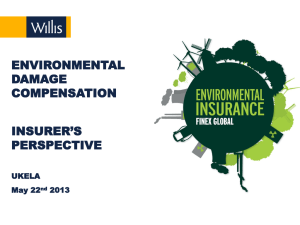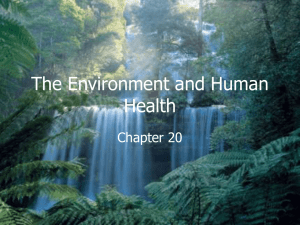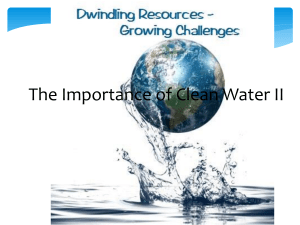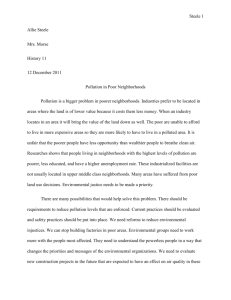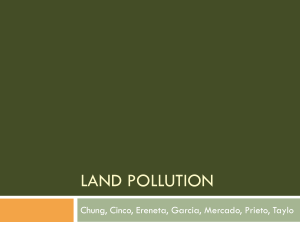Heavy Metal Pollution in Farmland
advertisement
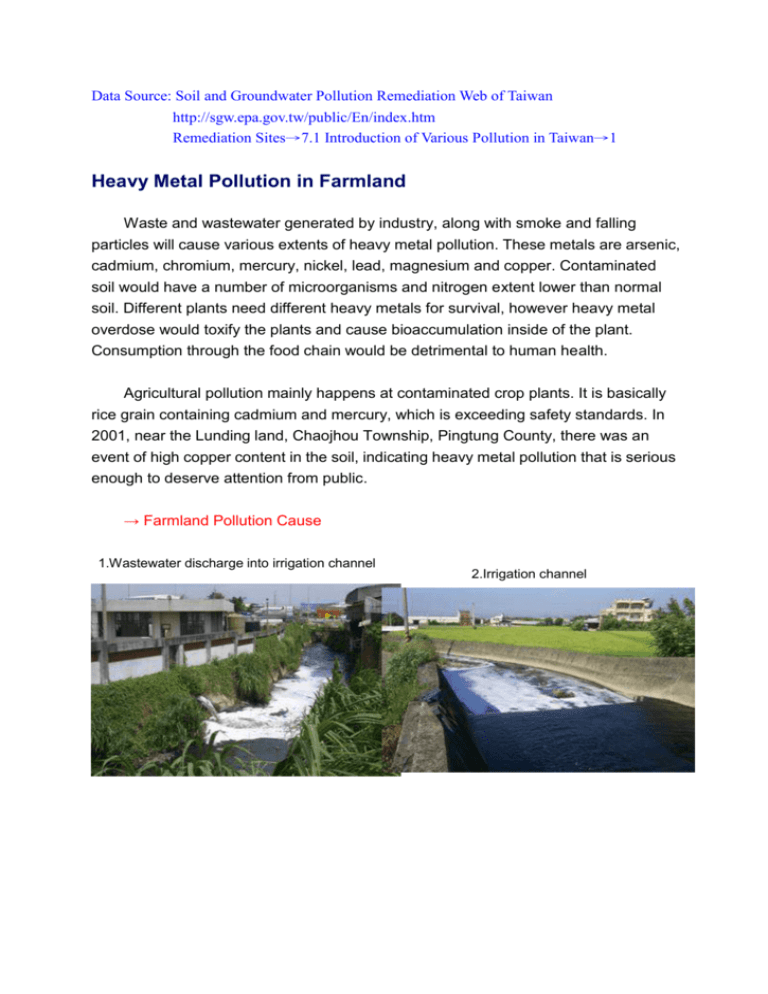
Data Source: Soil and Groundwater Pollution Remediation Web of Taiwan http://sgw.epa.gov.tw/public/En/index.htm Remediation Sites→7.1 Introduction of Various Pollution in Taiwan→1 Heavy Metal Pollution in Farmland Waste and wastewater generated by industry, along with smoke and falling particles will cause various extents of heavy metal pollution. These metals are arsenic, cadmium, chromium, mercury, nickel, lead, magnesium and copper. Contaminated soil would have a number of microorganisms and nitrogen extent lower than normal soil. Different plants need different heavy metals for survival, however heavy metal overdose would toxify the plants and cause bioaccumulation inside of the plant. Consumption through the food chain would be detrimental to human health. Agricultural pollution mainly happens at contaminated crop plants. It is basically rice grain containing cadmium and mercury, which is exceeding safety standards. In 2001, near the Lunding land, Chaojhou Township, Pingtung County, there was an event of high copper content in the soil, indicating heavy metal pollution that is serious enough to deserve attention from public. → Farmland Pollution Cause 1.Wastewater discharge into irrigation channel 2.Irrigation channel 3.Farmland uses polluted water to irrigate the 4.Heavy metal content is exceeding the crop. standard. Inspired by the instance of Japanese rice grain cadmium pollution and that our water reserved for crop irrigation keeps being polluted by discharged wastewater, beginning 1983 EPA began to survey the meal content in the soil, and we assigned food crop farming area as a remediation priory. According to the law, the polluter is being punished, and the polluted site is remeidated according to the remediation plan. In May 2000, Soil and Ground Water Remediation Transition Executive Measures stipulates that local responsible agency shall survey, monitor, and remeidate the polluted sites according to the “Heavy Metal Content Allocation Map” and “Heavy Metal Content Category” Remediation. Since 1982, 1600 hectares of land has been divided into 4 kilometer square and heavy metal content is being surveyed. Heavy metal content is categorized into five different types; Grade 5 is the most serious and requires immediate attention. Each local government reports its Grade 5 polluted area for a total of 319 hectares. In the year 2002, Taiwan EPA began an investigation and enlisted polluted land as control sites according to the pollutant standard. Each local government is actively involved in the remediation action. → Farmland pollution survey and investigation Surveying on the soil pollution farm land is classified into 5 stages: Stage I. (1982~1986) Major sized sampling area (1,600 hectares) sampling and surveying Stage II. (1987~1990) Mid sized sampling area (100 hectares or 2.5 hectares) sampling and surveying Stage III. (1992~1999) Mini sized sampling area (1 hectare) sampling and surveying Stage IV. (2000~2001) meticulous sampling Stage V. (2002) Heavy metal content survey and polluted site classification In 2002, according to the " Survey of the Soil Heavy Metal Content in the Food Crop Area and Control Site Enlisting Project”, polluted farm land with Grade 5 (containing cadmium and mercury > 1 mg/L) will be surveyed by meticulous sampling analysis. Atotal 319 hectares of the farmland have been completely surveyed, and the environmental responsible agency will have investigation going on in accordance of Article 11, item 1 of the “Soil and Underground Water Remediation Act” Generally, the investigation result can be classified as the following: I. Report by the public or local environmental agency that investigates the land and concludes the farmland is being polluted. II. Council of Agriculture reports to us the rice grain contains toxic chemical which is exceeding the safety standard, and the environmental responsible agency investigate the suspicious site. Heavy metals investigated including arsenic, cadmium, chromium, mercury, nickel, lead, magnesium and copper, totaling 8 metals. Farm land heavy metal pollution survey Survey Sampling Sample Collection Soil Sampling → Farmland Pollution Emergency Responses The following emergency responses shall be adapted based on the actual pollution condition: I. Polluter shall be prosecuted and the pollution behavior shall be stopped by either shutting-down the operation or closing the business totally or partially. II. Investigate the responsible party causes the pollution and notify the local public to cease using the polluted water source and prohibit the water welling if necessary. III. Offering fresh water for daily life use in substitute of the polluted water source, if possible, the water company needs to have pipe established so the water source is still available. IV. Official notice shall be established, if the condition is serious, and polluted areas shall be isolated. V. Notifying relevant responsible agencies to survey and monitor the polluted agricultural and fishery products, destroy these products if necessary. Compensate the relevant parties if their products are destroyed. Prohibit the cultivation on the polluted farmland if necessary. VI. Evacuate or restrain residents if necessary. VII. Remove or dispose of pollutants. III. Other emergency response measures. 1.Survey the site before eradication 2a.Eradicate the crops 2b.Eradicate the crops 3.Remove the Crops 4a.Move the Crop to the Destroy Site 4b.Destroy Polluted Crop → Farmland Pollution Improvement Part of farmland uses polluted water for irrigation because the wastewater was discharged into the irrigation channel. Plants absorb this water and cause the heavy metal to accumulate inside of their bodies. The pollution source has to be investigated, bottom sludge has to be moved out and the irrigation system shall be separated from the discharge system. By doing these, water pollution will be lightened. Other than adopt emergency response, remediation is another major work that has to be carried out. For the farmland that has chromium, copper, nickel, and zinc, soil turn-over and dilution is a good option. For the soil polluted by cadmium, lead, and mercury, soil acid washing or heat treatment is optimum. Some other treatment methods like soil discharging or mixing is also worth considering. Beginning July 24 and September 13, 2002, EPA convened the “Remediation for Polluted Farmland” meeting, to discuss the executive process flow, establish an advisory committee, apply pollution control site remediation budget subsidies, and hold open bidding for remediation. A local bureau has to establish a special team to inspect the remediation progress. Once the remediation is completed, the special team will inspect the result and decide if the site is delisted. Land Pollution Remediation --- Soil Turn-Over and Dilutio 1.Dig-out and Exposure under Sunlight 4.Shatter, Mix and Dilute 2.Make Screening Bed 5.Second Horizontal Mix 3.First Horizontal Mix and Shatter 6.Compact Refill Restoration Condition 1.Drive the Plowing Machine into 2.Plowing Machine is Turning the 3.Move the Organic Fertilizer into the Remediation Site Surface Soil Over the Remediation Site 4.Apply Organic Fertilizer 5.Restart to Grow 6.After Remediation Photo Sources: Taiwan EPA and Each Local Environmental Protection Bureau

